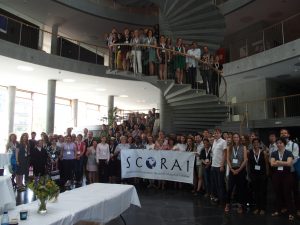How does this reveal itself?
By: Sandra Schmidt
About me: I am an agricultural biologist and sustainability manager, and I have worked in the food trade for my entire professional life. For the past 1 ½ years, I have been working as a manager working with organic value chains for vegetables, potatoes, and legumes as part of the German federal funding program KA.WERT. My task is to bring together regional stakeholders and ensure that the chain from the agricultural farm to the restaurant, cafeteria, and retail stores is brought closer together. This project is embedded in the organization “FoodCircle“, which aims to establish a regional, non-profit nutrition center.
Even with classic sustainability parameters, scientific assessment plays an important role in decisions for the benefit of the global community. When evaluating the quantity and costs in the agricultural and processing stages, one quickly thinks of non-living production resources such as water, energy, transportation, or material consumption (cover cloths, machinery, pesticides, equipment, etc.).
Resources are generally thought to be easy to measure, but in an organic farm, including seasonal vegetable cultivation from cauliflower to zucchini, as well as grain cultivation and beef cattle farming, it is very difficult to measure resource consumption of individual products. A farmer does not have time to do all this data collection, and often lacks the necessary training. Help from the scientific community is absolutely necessary here.
Such “fixed” values were already important in my professional career in 2009 to calculate the carbon footprint. These values were then part of sustainability reports for clients, such as a well-known fast-food chain. Later, these values began to be used as a basis for deciding which foods to prioritize in our diet for sustainability reasons.
For example, the choice between fresh apples from New Zealand or German apples from cold storage was highlighted in the German media before the turn of the millennium, prompting many consumers to rethink seasonal eating. Sustainability indicators also influence consumer decisions at the point of sale. In this project, we will take a closer look at the carrot, which in my opinion is not a topic for the majority of the population.
The question of whether the carrot, which is available year-round except in May, can be fresh from the ground or from storage, or even imported, has not really been in the spotlight. The focus on the carrot has rather been on another sustainability factor: “food waste”. The “crooked” carrot became a symbol of discarding foods that do not meet customer expectations.
Experts estimate that about half of the discarded carrots, which cannot be marketed due to cosmetic defects, would actually be edible, amounting to 10 to 20% of the total quantity. Our federal government has set a goal to halve food waste by 2030. It also supports projects by discounters, such as the brands “Krumme” and “Bio-Helden”, which offer these carrots in bags at discounted prices. Offering a discount on this product means that less affluent classes are able to participate in sustainability who might not otherwise be able to access it. In the factor of food waste, the entire value chain is already being examined, helping to implement important political decisions for the food market, such as dropping strict trading class regulations.
The most well-known example of the benefits of sustainability assessment is the “planetary health diet”: The recommendations for eating more nuts and plant-based protein in the form of legumes and less meat are the result of a panel of experts in health, agriculture, policy and environmental sustainability from 16 countries. They have developed evidence-based, global goals for healthy eating and sustainable food production.
Food production is one of the most significant contributors to greenhouse gas emissions and the loss of biological diversity, consuming 70% of freshwater. This diet has led to changes in certifications, especially for kindergarten and school cafeterias. Company cafeterias are slowly following suit. As a result, this change will lead to a reduction in agricultural land for livestock farming and an expansion of land for legumes. This will create a more diverse agricultural landscape. Furthermore, new business models are developing at the processing stage of the value chain. Start-ups that develop products from plant-based proteins are being established. This results in a larger selection of vegan foods and more people opting for vegan meat alternatives more frequently.
Back to our project: We want to use the sustainability assessment in our project to demonstrate how far organic carrots from the region pose less of a burden on our planet than conventional carrots from further away.
True Cost Accounting is the calculation of all costs incurred in the production of the product. This includes sustainability factors such as soil pollution, water pollution, biodiversity reduction, as well as the psychological and physical burdens and occupational diseases of employees all being included in the calculation. According to AMI (Agrarmarkt Informations-Gesellschaft mbH) and the Thünen Institute, organic farming is rated much higher than conventional farming in factors such as water, soil biodiversity, climate protection, climate adaptation, resource efficiency, and even animal welfare.
Ecological food manufacturers on the meso-level can use the benefits in their communication with consumers and at the same time minimize their procurement risks using the data presented above. Calculating these factors regionally for our project would be too extensive. However, it is reflected in the EU Commission’s Green Deal and Farm-to-Fork Strategy. The German government has adopted the demand for 30 % organic by 2030, which hopefully will also impact the increase in organically cultivated areas in our region. As FoodCircle we will do our share to make this increase possible.


